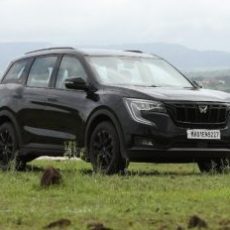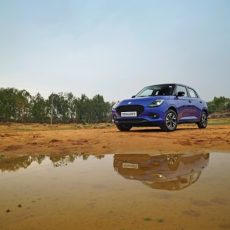The country’s largest car maker has a lot going on behind the scenes. Car India was among the small group invited to the Maruti Suzuki R&D Centre in Rohtak, Haryana to see exactly what goes into building their cars.
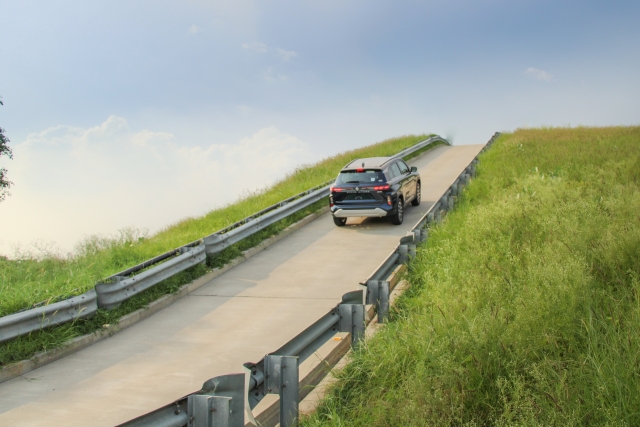
Maruti Suzuki are India’s leading automakers and by some margin with anywhere between 40 and 50 per cent market share over the past few years, at times earlier even more than that, it’s not inaccurate to say that half the cars on the road are Maruti Suzukis and the remaining half is everybody else. Now, times are a-changing. New norms and regulations necessitate more study, research and testing and Maruti Suzuki were ahead of the curve even there. World-class cars need world-class resources and we were given an insight into the Maruti Suzuki R&D Centre in Rohtak, Haryana.
Spread over 600 acres, the Maruti Suzuki R&D Centre in Rohtak is one of the most advanced facilities in India and amongst the best in Asia. The integrated R&D Centre has state-of-the-art vehicle testing and evaluation labs as well as a world-class proving ground with a unique set of test-tracks. With an investment or Rs 3,800 crore, the Rohtak test track was commissioned in November 2014. Developed with Suzuki’s technical know-how, it can emulate all the conditions necessary as the proving grounds of Suzuki Motor Corporation, Japan. The Rohtak proving ground was designed keeping in mind global and Indian road conditions. More importantly, several necessary upgrades are done in the facilities to evaluate vehicle performance to suit the evolving market needs.
Maruti Suzuki have been entrusted with the development of new models with focus on localization of parts and vehicle performance requirements from various markets and regulatory changes based on Suzuki’s global platform, powertrains and technology ensuring world-class quality underpins all progressive stages of vehicle development. Over the last 20 years, the company has trained engineers in Suzuki, Japan and uses their skills and learning to develop the new range of vehicles–the new Baleno, Brezza and the all-new Grand Vitara–from the Maruti Suzuki R&D Centre.
Also read: Maruti Suzuki Grand Vitara Driven
All the vehicles are rigorously tested and evaluated at the assessment labs, crash-test facility and proving ground at the Maruti Suzuki R&D Centre to meet the advanced regulations as well as their ever-tightening internal design and testing norms. Each vehicle undergoes numerous tests and evaluations during design and development over a span of three to four years and we were witness to some of the major test procedures.
The fifth-generation “HEARTECT” platform is the base for their new compact cars. It is designed to direct the crash energy from the vehicle front to the rear keeping the occupant compartment cell intrusions to the minimum. It also ensures that the safety systems such as primary restraint system (seat belt) and secondary restraint system (SRS airbags) remain in the correct position to provide maximum protection to occupants. The use of new materials such as high-tensile steel makes the body stronger and safer while being lighter. Many other innovations, big and small, have enabled Maruti Suzuki to overcome the trade- offs and optimize advanced safety along with superior emission and performance.
We were taken for a brief look inside some of the major facilities after our exclusive drive experience of the all-new Grand Vitara. Here are the details of the major facilities we visited.

Vehicle Semi-anechoic Chamber with Integrated Chassis Dynamometer
The Vehicle Semi-anechoic Chambers (VSACs) Chassis Dynamometers are used for the noise, vibration and harshness (NVH) refinement of vehicles. In this facility design optimization of various sub-systems including powertrain, intake, exhaust are carried out for achieving desired refinement levels and acceptable NVH attributes in a vehicle. This state-of-the-art testing facility is one of the quietest rooms available in India. These temperature-controlled chambers are integrated with high-performance dynamometers which can attain high driving speeds of up to 250 km/h. The unique properties of this facility enable it to measure vehicle NVH data in a controlled and repeatable environment eliminating the influence of ambient weather conditions.
Drivetrain Testing
The powertrains developed by Maruti Suzuki are thoroughly assessed on test benches under extreme temperature conditions apart from actual driving tests to evaluate their durability, efficiency and other drivetrain related performance parameters. The drivetrain testing facility is equipped to evaluate various types of transmission including manual (MT), automated manual or auto gear shift (AGS), automatic (AT), continuously variable (CVT), hybrid, and electric under different vehicle configurations namely FF (front-engine-front-drive), FR (front-engine-rear-drive), as well as all-wheel drive (AWD and 4WD). These tests are done to ensure optimum performance and fuel efficiency in addition to reliability in actual vehicle.
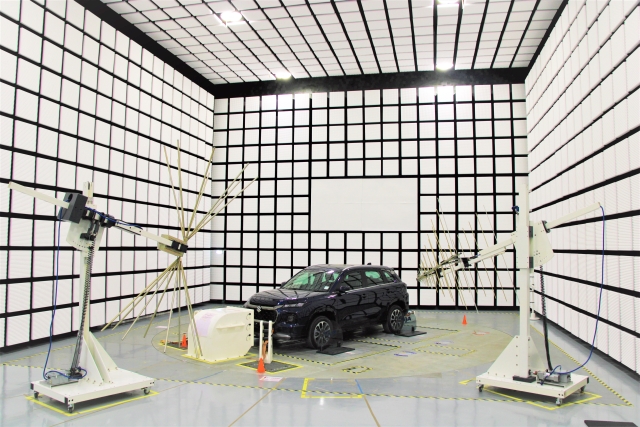
Electromagnetic Compatibility (EMC) Testing
The state-of-the-art semi-anechoic chamber test facility for EMC performance of the vehicle sees various tests carried out to check unwanted electromagnetic disturbances emitted by the vehicle and to ensure that no malfunction occurs due to electromagnetic and radiation interference from the external environment. Huge antennae bombard the car with radiation to check that the cabin is adequately insulated and protected.
Tyre Coupled Road-load Simulator – Full Vehicle Durability Testing
A tyre coupled road load simulator is used for full vehicle durability inside a lab environment. It’s a uni-axial loading actuator system which can apply vertical forces up under the four wheels of the vehicle.
It uses a high-end simulation software that can reproduce the loads experienced by a vehicle on rough roads with a simulation of very high accuracy. It has inbuilt features that enable it to run continuously to reduce the test time. These can emulate rough roads, rumble-strips, undulations and various other scenarios. The adjustable set-up supports multiple wheelbase and track width vehicles effortlessly allowing the entire vehicle line-up–from the Alto to the Grand Vitara–to be tested on same machine by changing the mounting point positions. A separate, more advanced six-arm set-up allows even more intense testing with a six-axis capability.
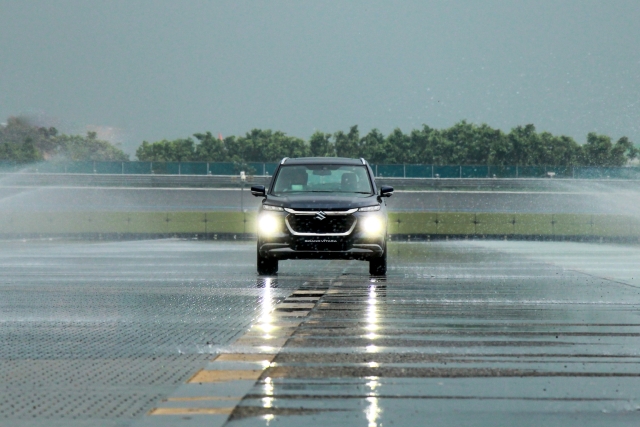
Low Friction Road
A multi-friction track allows for testing of brake components and traction and this is specifically used for brake system performance testing. It has multiple surfaces with different coefficients of friction which simulate varying road conditions from wet asphalt to snow or ice. The surfaces have been custom-built by importing specific tiles from Europe and Japan for achieving precise and consistent friction values. It is also equipped with a fully automated and remote-controlled watering system having closed loop sprinklers and nozzles to create thin and uniform film of water for achieving low μ conditions. The track is capable of replicating real-world conditions in which the vehicle is subjected to extreme braking requirements. This track is extensively used for tuning and development of critical braking systems such as the anti-lock braking system (ABS) and the Electronic Stability Program (ESP) for optimal performance and response in actual usage for maximum safety.
Crash Testing
Unbeknownst to many, Maruti Suzuki conduct a series of rigorous crash-tests for their vehicles to ensure protection of the occupants in the event of a severe accident. Full vehicles, equipped with latest advanced dummies of various sizes and myriad sensors, are used to evaluate the protection offered by the vehicle structure, safety equipment and interior components of the vehicle. The vehicle structure, comprising an energy-absorbing crumple zone, deformation sections and a highly protected occupant zone, is supplemented by a specifically-tuned restraint system to offer maximum protection to the occupants. The tests include: frontal impact, side impact, pedestrian impact, rear impact, low-speed impact, pole impact, side pole impact, offset impact, and various airbag sensor calibration with as many as 50 different tests being performed.
We were witness to the AIS-197 test ahead of Bharat NCAP implementation for the new Brezza. This test requires an aluminium honeycomb barrier for an offset front impact at 56 km/h. The test is performed at the Maruti Suzuki R&D Centre’s crash test facility at 64 km/h. Cameras record the crash at as many as 100,000 frames per second, necessitating the use of high-intensity flicker-free lighting.
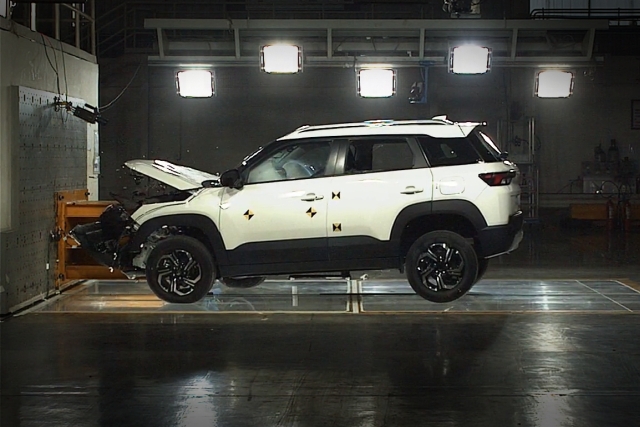
Thus, in every new Maruti Suzuki vehicle, there is a lot that goes into optimising it to make it not just safe, but also comfortable for use everywhere and every day. All test tracks at the Maruti Suzuki R&D Centre in Rohtak are based on Suzuki Motor’s global test standards and with their intense technical know-how.


